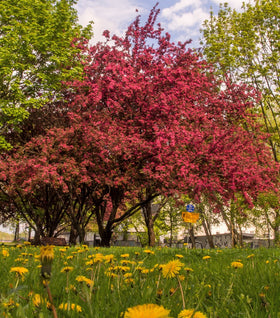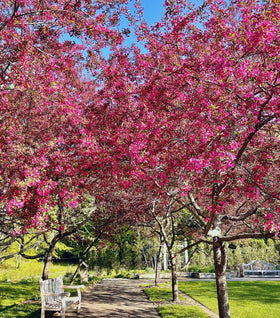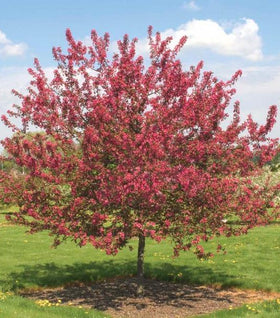Crabapple Trees
Crabapple trees deliver big-show spring flowers, clean summer foliage, glowing fall color, and ornamental fruit that feeds birds through winter—four seasons of payoff in one low-maintenance tree. We curate disease-resistant, landscape-proven selections with reliable bud set, strong branching, and tidy habits that behave beautifully in front yards, along drives, and by patios.
When you buy crabapple trees online from Garden Goods Direct, you get nursery-grown, zone-ready stock plus straightforward guidance on spacing, pruning, and siting for the best bloom and fruit display. We ship fast and back every order with our "We Grow Together" Promise, so you can plant with confidence and enjoy a spring show that stops traffic.
Why Choose Crabapple Trees: Signature Spring Bloom, Fruit, and Year-Round Structure
Crabapples are the ultimate four-season ornamentals: clouds of pink or white blossoms in spring, lustrous green foliage in summer, amber-to-scarlet fall color, and persistent red or orange fruit that looks like jewelry against winter skies. Our assortment emphasizes compact to medium sizes that fit modern lots while still creating a dramatic floral moment.
Today’s improved selections offer excellent disease resistance (to apple scab, rust, and mildew), heavy flowering, and fruit that hangs for months, drawing songbirds and adding curb appeal long after leaves fall. Whether you need a single statement tree or a repeating rhythm down a driveway, crabapples make spaces feel designed and welcoming.
Habit & Color Through the Seasons: Vase Forms, Rounded Crowns, and Persistent Fruit
Expect elegant silhouettes—from rounded canopies to upright-vase forms and graceful weepers—that cast dappled shade without overwhelming beds beneath. Flower color spans pure white to shell pink and deep rose, often opening before leaf-out for maximum impact.
After the blossom show, many varieties set abundant, marble-sized fruit in shades of red, coral, or gold. Leaves transition from fresh green to warm fall tones, and the tree’s fine branching and decorative fruit keep interest all winter.
Design That Works: Front-Yard Focus, Driveway Allees, and Wildlife-Friendly Borders
Front-Door Statement: Place one near the entry and underplant with spring bulbs and low evergreens to frame the bloom.
Drive & Walkway Rhythm: Repeat a single variety at consistent spacing for a flower tunnel each spring.
Patios & Small Spaces: Select compact cultivars to introduce high-impact color without requiring deep shade; fruit adds winter interest and attracts bird activity.
Crabapples also support early pollinators, provide food for birds, and create a seasonal focal point that elevates the entire planting plan with minimal upkeep.
Easy Care Basics: Planting, Spacing, Pruning, and Disease-Smart Choices
Give crabapples full sun (6–8+ hours) and well-drained soil. Plant with the root flare at or slightly above grade in a hole twice as wide as the root ball. Backfill with native soil, water deeply, and mulch 2–3 inches (off the trunk). Maintain even moisture levels throughout the first season; thereafter, perform deep, occasional soaks during dry spells to preserve foliage quality.
Prune lightly immediately after bloom to refine the shape and remove crossing or damaged wood; avoid heavy winter cuts that may sacrifice spring flowers. Select disease-resistant cultivars whenever possible and water at the base to keep foliage dry.
Spacing guide: Compact trees are often 10–15 ft on center; larger forms are 15–20+ ft, or tighter if you want a fast-growing allée.



